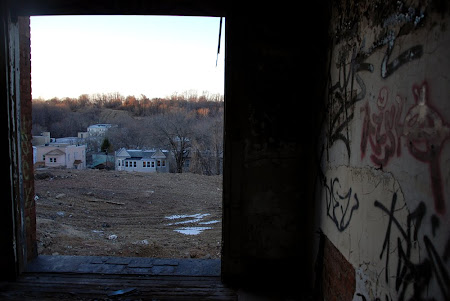Samuel R. Smith Infirmary

January 25, 2012 -
An abandoned castle sits on a hill in Staten Island. Its windows are boarded up. Its roof is collapsing. Inside, its interior has been gutted by arson and decay. Graffiti artists have covered the walls with anonymous tags and several floors are missing. Rain, snow and wind flow through the empty space. Once, this 122-year-old ruin was "like a fairy-tale palace," according to the Staten Island Advance, and a "spectacular Neo-medieval style brick structure," according to Staten Island Treasures. Named the Frost Memorial Tower, it was the cornerstone of the Samuel R. Smith Infirmary, Staten Island's first non-profit volunteer hospital. This 6-acre complex opened its doors in 1890, and was renamed the Staten Island Hospital in 1916. "Generations of Staten Islanders were born at the former Staten Island Hospital site," according to the Staten Island Advance, but that was before the hospital moved in 1979, leaving their old campus to rot.
Today, the city is planning to demolish the Frost Memorial Tower, unless the building first collapses under the weight of this winter's snow. Yet despite the destruction caused by three decades of abandonment, the Frost tower has remained an iconic neighborhood presence. "Activists say the building is one of the most important, beloved, and beautiful buildings on Staten Island," according to the Staten Island Advance, and several Staten Island groups have worked towards preserving the building. These include the Coalition to Save the SI Castle and the Preservation League of Staten Island, which has led rallies, organized a petition, and started a "Save the Castle" Facebook group. The New York Landmarks Conservancy has placed the Frost Memorial Tower on its Endangered Buildings Initiative list, but notes that "despite repeated requests for evaluation, the building has not been heard by the Landmarks Commission."
Over the years, the abandoned Samuel R. Smith Infirmary complex has also attracted the attention of several more destructive groups. "Homeless, drug addicts and vandals have made it their playground," according to the Staten Island Advance, and "the Fire Department has to pay regular visits there to extinguish fires." The most recent fire was a March 2011 blaze in the Frost tower, and "emergency responders were bracing for squatters in the structure... but thus far initial searches have turned up negative," according to the Staten Island Advance. The decline of the hospital complex began almost immediately after it was closed, according to a Staten Island resident called The Wasp, who wrote that in 1980 - over the course of less than one year - the abandoned campus went from a place where "guard dogs were being allowed to patrol the [main] building at will" to a space where "anything left behind by the hospital move had since been stolen if it had any value. Copper wire and light fixtures had been ripped out and removed. Door knobs, switch panels and sink fixtures were all gone."
The main hospital building, which stands next to the the Frost Memorial Tower, bore the brunt of the damage. "There was plan in the mid-eighties to turn them into condos," according to The Wasp, "but that was a money laundering scheme that left dozens of tenants ripped off and in debt. Over the years a few con men set themselves as the rightful owners and let people rent the apartments from them but they were eventually evicted by the city and the lower floors of the buildings sealed with cement." By 2005, the entire campus was half-demolished and rotting, according to the Urban Exploration website Opacity: "Clambering through the rubble of the bulldozed infirmary wing and into the large six story building, we were greeted with a few inches of standing water and air so stagnant that the mold was tangible in our noses and mouths." A visit to the main building in 2007 revealed abandoned apartments with kitchens and living rooms destroyed by vandals, while the Frost building was a gutted ruin overgrown with trees. By 2009, the Urban Exploration website The Kingston Lounge predicted that the campus would "either be demolished by the hand of man, or just left to demolition by neglect."
In November 2011, the city began taking steps to tear down the remaining hospital buildings. "The city Buildings Department issued an emergency declaration in June to demolish what formerly was Staten Island’s first voluntary hospital," according to the Staten Island Advance. "The HPD has hired a demolition company, and site preparation work started earlier this week to clear a safety zone." The overgrown land around the hospital campus has since been bulldozed, removing trees and rubble. Some residents remain hopeful that they may still find a reprieve for the Frost building, but, as the Staten Island Advance pointed out in a 2009 editorial, "If the long-abandoned Frost Memorial Tower is landmarked, then what? Landmarking, in and of itself, saves nothing. It prevents the owners of landmarked properties from making changes perhaps. But it does nothing to protect abandoned buildings."
Examples of this can be seen throughout New York City, where many officially landmarked buildings have been left to rot, including Staten Island's abandoned Farm Colony complex and collapsing Physician-in-Chief's residence at Bayley-Seton Hospital, and Brooklyn's hollowed-out 68th Police Precinct and crumbling Domino Sugar Refinery. Even if the supporters of the Frost Memorial Tower are somehow successful in defending the castle, it would take millions of dollars and many years to stabilize and repair this long-neglected structure. In the meantime, the tower slowly collapses, its dark interior empty and bitterly cold. These photographs take a last look inside.
---
For photo essays on abandoned New York City landmarks, please visit The New York City Farm Colony (2011), The 68th Police Precinct (2011), Victim Services (2008) and The Domino Sugar Refinery (2007).























Wonderful pictures and history, thank you!
ReplyDeleteI particularly like that last shot looking out into the world from the ruin. Nice.
ReplyDeleteIt's so wonderful, I wish I'd gone in before they tore it down. I was JUST not quick enough. C'est la vie.
ReplyDeleteI believe I was born in this hospital in July 1935
ReplyDelete